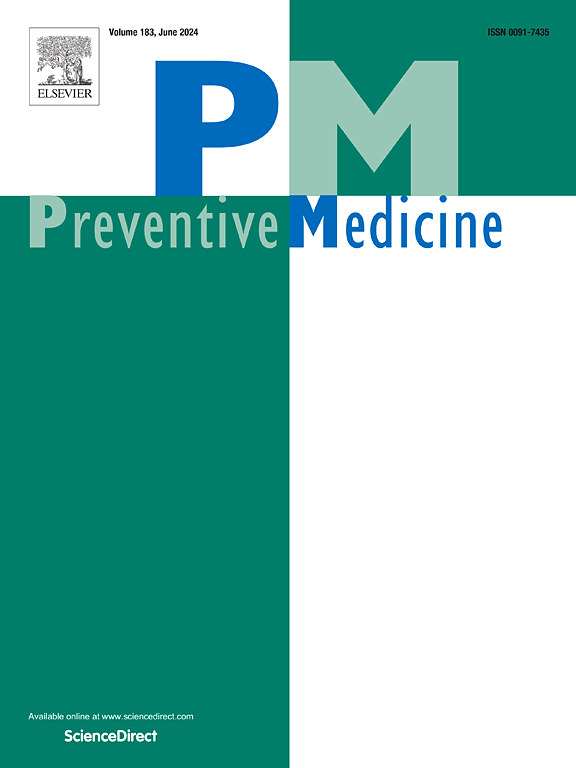美国成年人中与人类乳头瘤病毒 (HPV) 患者和医生沟通以及 HPV 疫苗接种率相关的因素。
IF 3.2
2区 医学
Q1 MEDICINE, GENERAL & INTERNAL
引用次数: 0
摘要
目的:人乳头瘤病毒(HPV)疫苗被批准用于9-45岁 岁人群。然而,在美国,HPV疫苗的接种率仍然不理想,特别是在年轻人和中年人中。本文描述了HPV疫苗患者与临床医生的沟通,临床医生的建议接收,以及美国成年人中符合HPV疫苗接种条件的HPV疫苗摄取。方法:在2021年2月至3月期间,招募年龄在45岁以下和18岁以上的美国成年人进行在线调查(n = 1107)。采用多变量logistic回归分析评估:(1)临床-患者HPV疫苗接种讨论;(2)曾经接受过临床医生的HPV疫苗推荐;(3) HPV疫苗摄取。结果:34%的参与者报告曾与临床医生讨论过HPV疫苗,31.1% %报告曾收到临床医生对疫苗的建议,只有23.8% %报告接受了疫苗。接种HPV疫苗与既往HPV疫苗讨论呈正相关(aOR: 2.93;95 % CI: 1.98-4.35)和曾经接受过临床医生的HPV疫苗推荐(aOR: 10.64;95 % ci: 7.14-15.88)。与所有三种模式(讨论、接受临床医生建议和接种疫苗)一致相关的其他因素包括更高的HPV疫苗知识和更高的HPV疫苗尴尬。结论:未接种疫苗的适龄成人错过了hpv相关癌症预防的机会。需要采取干预措施,支持临床医生为青壮年提供护理,以增加临床医生对HPV疫苗的讨论和建议,以及患者对HPV疫苗的接受。本文章由计算机程序翻译,如有差异,请以英文原文为准。
Factors associated with human papillomavirus (HPV) patient-clinician communication and HPV vaccine uptake among adults in the United States
Objective
Human papillomavirus (HPV) vaccine is approved for those aged 9–45 years. However, HPV vaccine uptake remains suboptimal in the United States (U.S.), particularly among young and mid-age adults. This paper describes HPV vaccine patient-clinician communication, clinician recommendation receipt, and HPV vaccine uptake among U.S. adults who were eligible for the HPV vaccine as adults.
Methods
U.S. adults up to age 45 and who were aged 18+ when the HPV vaccine was approved were recruited for an online survey (n = 1107) between February–March 2021. Multivariable logistic regression analyses were used to assess: (1) clinician-patient HPV vaccination discussions; (2) ever having received an HPV vaccine recommendation from a clinician; and (3) HPV vaccine uptake.
Results
Thirty-four percent of participants reported having prior HPV vaccine discussions with a clinician, 31.1 % reporting ever having received a clinician recommendation for the vaccine, and only 23.8 % reported receiving the vaccine. Receiving the HPV vaccine was positively associated with prior HPV vaccine discussions (aOR: 2.93; 95 % CI: 1.98–4.35) and ever receiving an HPV vaccine recommendation from a clinician (aOR: 10.64; 95 % CI: 7.14–15.88). Additional factors consistently associated with all three models (discussing, receiving a clinician recommendation, and vaccine uptake) include higher HPV vaccine knowledge and higher HPV vaccine embarrassment.
Conclusions
Unvaccinated age-eligible adults represent a missed opportunity for HPV-related cancer prevention. Interventions to support clinicians providing care to young and mid-age adults are needed to increase clinician discussions and recommendations of the HPV vaccine and patient uptake of the HPV vaccine.
求助全文
通过发布文献求助,成功后即可免费获取论文全文。
去求助
来源期刊

Preventive medicine
医学-公共卫生、环境卫生与职业卫生
CiteScore
7.70
自引率
3.90%
发文量
0
审稿时长
42 days
期刊介绍:
Founded in 1972 by Ernst Wynder, Preventive Medicine is an international scholarly journal that provides prompt publication of original articles on the science and practice of disease prevention, health promotion, and public health policymaking. Preventive Medicine aims to reward innovation. It will favor insightful observational studies, thoughtful explorations of health data, unsuspected new angles for existing hypotheses, robust randomized controlled trials, and impartial systematic reviews. Preventive Medicine''s ultimate goal is to publish research that will have an impact on the work of practitioners of disease prevention and health promotion, as well as of related disciplines.
 求助内容:
求助内容: 应助结果提醒方式:
应助结果提醒方式:


